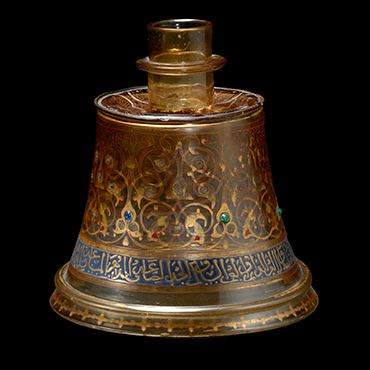This is an exceptionally rare example of a candlestick made of enameled and gilded glass, produced for an elite patron in the medieval Arab world. In terms of technique, style, and the nature of the glass body, this piece fits perfectly within Mamluk glass production. In the 14th century CE, the renowned Mamluk glass workshops of Egypt and, more particularly, Syria crafted the finest enameled and gilded glass produced anywhere. This was intended not only for local consumption but also diplomatic gifts, and the flourishing export market. In this case, the inscription around the base of the candlestick offers general good wishes to the owner in rhyming couplets, which indicates it was made for a local courtly patron.
The overall decoration of the body, with gilded palmettes and arabesques outlined in enamel, compares to that of a number of glass mosque lamps produced for the enormous Sultan Hasan mosque in Cairo (built AH 757–64/1356–63 CE). An unusual feature of this candlestick is, however, the use of large enamel bosses—the few remaining examples of which stand proud of the surface. These probably imitated jewels set into silver and gold works of art. The overall shape of the candlestick is certainly based on metalwork examples widely produced in the same period and surviving in large numbers. Conversely, surviving glass candlesticks are fewer in number, with only one other example known in this material.
In the first published mention of this candlestick in AH 1328/1910 CE, it was described as having been found in a collection in China, as were two other Mamluk enameled glass works of art in the Eumorfopoulos collection. There had been a vigorous exchange of goods between China and the Mamluk Empire in the 8th and 9th centuries AH/14th and 15th centuries CE , and the Chinese provenance of this spectacular candlestick may be a rare witness to this cultural interchange.
Candlestick
Syria or Egypt, mid-8th century AH/14th century CE
Glass, glass enamels, gilding, h. 18.2 × diam. 17.5 cm
The Al Thani Collection, ATC256

